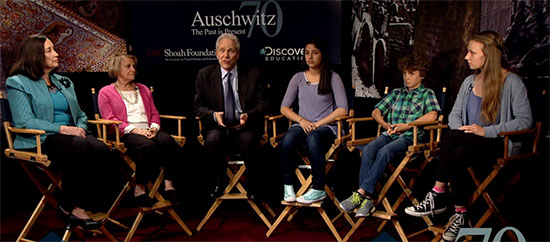Auschwitz: The Past is Present Virtual Experience Engages Classrooms Across the Country


Thousands of students and teachers tuned in for USC Shoah Foundation and Discovery Education’s Auschwitz: The Past is Present Virtual Experience last Wednesday. The 45-minute live-streamed broadcast provided a personalized look at USC Shoah Foundation’s recent trip to Poland for the 70th anniversary of the liberation of Auschwitz.
Classrooms from all over the country were able to view the virtual experience, hosted by Hall Davidson and filmed on the USC campus. The panelists were Holocaust survivor Paula Lebovics; UC Shoah Foundation Junior Interns Gabe Hackel, Anna Hackel and Lucia Wiedeman; Arkansas teacher Karen Wells and Director of Education Kori Street. All participated in the Auschwitz: The Past is Present professional development program in Poland in January 2015.
The broadcast began with an introduction to the Auschwitz: The Past is Present program, explaining to viewers that 25 teachers and 10 junior interns traveled to Warsaw and Krakow Jan. 23-28, 2015, to attend the official commemoration of the liberation of Auschwitz at Auschwitz-Birkenau State Museum, visit museums and historical sites, and learn from testimony about how to keep the past alive and relevant for current and future generations.
Davidson asked Anna what it was like to meet Paula after watching her testimony before the trip. Anna said Paula helped put a face and a name to the Holocaust and made it more real than just the facts she learned in school. She had been especially moved to hear Paula talk about the big family dinners she used to have as a young girl before the Holocaust, when she would sing at the top of her lungs to get her family’s attention, because she has a younger brother herself and could relate to Paula’s childhood.
Lucia said that she felt a “gravitational pull” toward Paula when she watched her testimony.
The first place the junior interns visited in Poland was the Museum of the History of Polish Jews, which showed them the rich history of the Jewish community before it was destroyed by the Holocaust. Lucia said she learned just how much Jewish culture had flourished before the war, and that “World War II interrupted them.”
Next, they visited the Jewish Cemetery in Warsaw, which contains the graves of many ancestors of people who were killed in the Holocaust. Gabe said that seeing how so many of the headstones were falling apart made him realize that that the people who should have been taking care of them were murdered.
“Standing there in the cold, I felt transported back in time,” he said. “There’s a story behind it, and that’s the story I have to share.”
After a few days in Warsaw, the interns went to Auschwitz-Birkenau. There, they saw the actual places where people had been murdered, and looked at the Book of Names, which contains 4.5 million names of people who were killed in the Holocaust, and photographs of prisoners. Anna said this made Auschwitz feel so much more real for her and she could imagine these real people actually being there.
Throughout the broadcast, the panelists answered questions sent in by students and teachers. One teacher asked Karen Wells how the trip to Poland has changed how she will teach about the Holocaust.
Karen said she will incorporate testimony into her lessons and teach students about their responsibility in global society. She recalled telling Paula that she didn’t think she could fully understand the Holocaust, and Paula said she didn’t have to; it is her responsibility as an educator to make sure students know to speak up against something that’s wrong.
“Their responsibility is to stand up,” Karen said. “With knowing comes responsibility.”
Paula said she decided a long time ago that “silence is not an option.” So whenever she is asked to speak about her experiences, she does. But she can’t make a difference all on her own; she needs people to hear her.
“[Students] are my listeners!” Paula said. “They have to hear.”
Another question came in for Kori Street, about how teachers can connect historical events like the Holocaust to current events, like ISIS and the Middle East. Street cautioned against drawing too many comparisons, since we have a different perspective on historical events than we are able to have on events currently happening, but said students can look at patterns and similarities in the ideologies of groups perpetuating violence. Both ISIS and the Nazis, for example, use hatred to galvanize and scare their followers.
Davidson closed the broadcast by asking Street what young people can do to honor the victims of the Holocaust. She said they can learn, ask good questions, think critically about what they see and hear in the media, have empathy and be willing to act.
Paula’s final words for the students were simple: “When you see injustice, stand up. Don’t sit idly by.”
Like this article? Get our e-newsletter.
Be the first to learn about new articles and personal stories like the one you've just read.